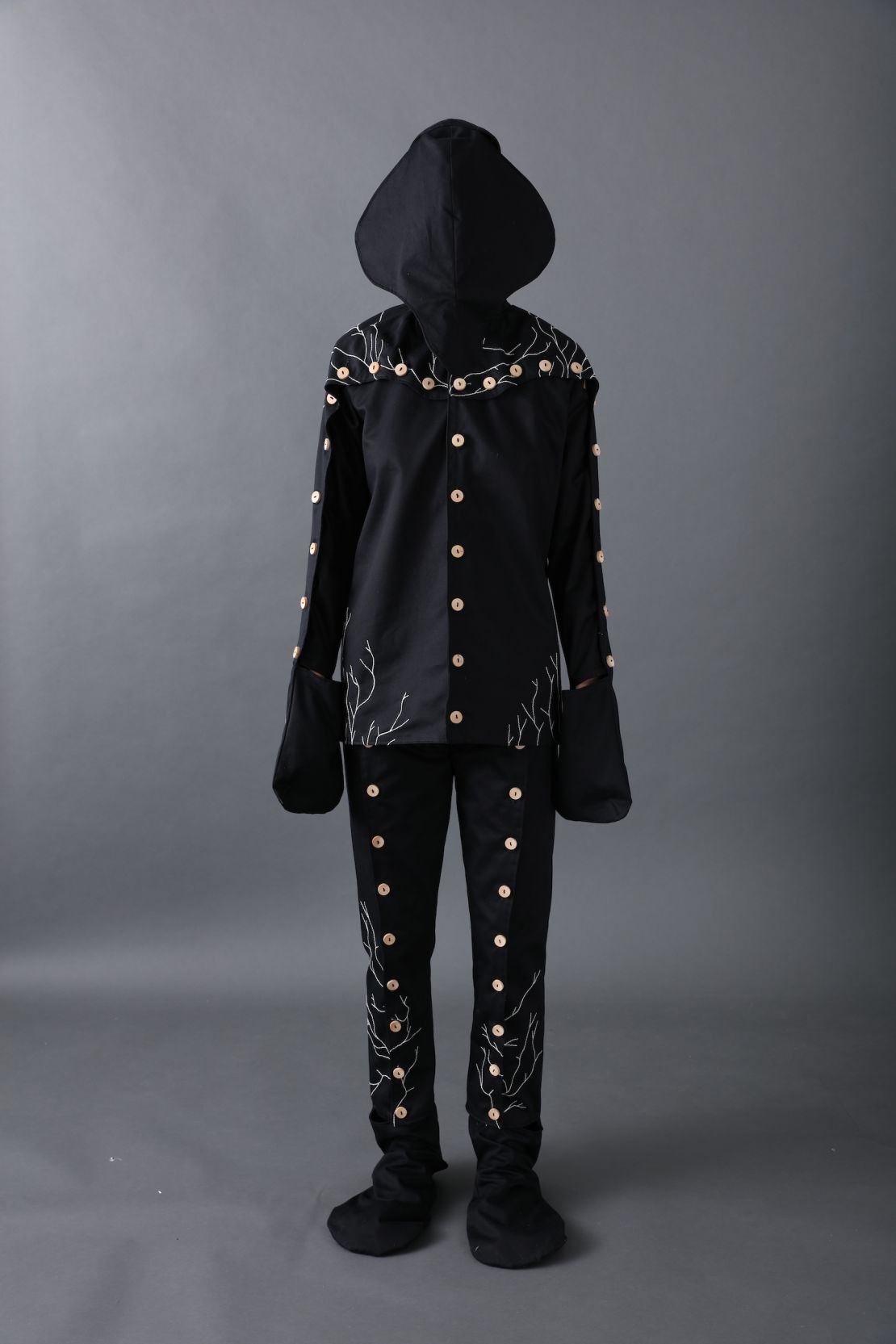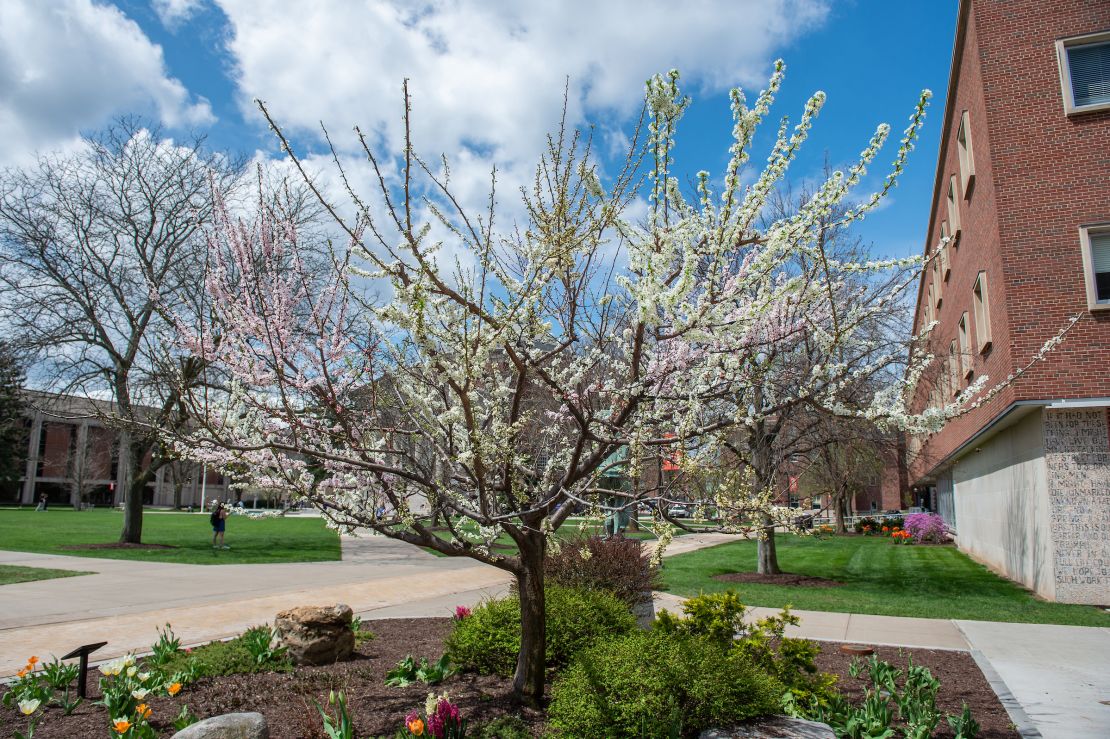Transgenic silk garments that emit a neon glow, sartorial burial suits embedded with flesh-eating microbes, and a bouquet of perfume notes derived from the DNA of extinct flora are just a few of the mind-bending works of design presented in “Nature,” this year’s Cooper Hewitt Design Triennial program.
Hosted simultaneously in New York and at the Cube design museum in Kerkrade, Netherlands, “Nature” looks at how designers are responding to human-induced climate change and the impending environmental crisis.
“Our planet and life as we know it are at a critical juncture. This is not just an exhibition: It’s a call to action,” said Cooper Hewitt director Caroline Baumann, citing recent data illustrating the extremes of climate change. Last year was the world’s fourth hottest since records started in 1880, according to NASA and the National Oceanic and Atmospheric Administration (NOAA).
The museum’s transcontinental effort is a timely amplification of “Broken Nature: Design Takes on Humanity,” the current Milan Triennial, which opened in March under chief curator Paola Antonelli.

“Even to those who believe that the human species is inevitably going to become extinct at some point in the (near? far?) future, design presents the means to plan a more elegant ending,” read the curatorial statement in a provocative call to arms.
Looking at the more than 60 projects in “Nature,” reflecting work from 22 countries, it seems that many players in the international design community have already taken note. Each of the works are placed into one of seven categories based on strategy, rather than medium – Understand, Simulate, Remediate, Salvage, Facilitate, Augment, and Nurture – and the cast of collaborators ranges from scientists, to engineers, farmers, programmers, artists, philosophers, and more.
That a notable number of works offer solutions to temper the industrial fast-fashion complex comes as no surprise. Clothing has been cited as among the top contributors of pollution and waste globally. In 2018, Quantis found that the footwear and apparel industries account for more than 8% of global greenhouse gas emissions, while, according to a 2016 McKinsey study, nearly 60% of all clothing ends up in landfills or incinerators within a year of its production.

The stylish Ultraboost sneaker, produced since 2016 by Adidas and the nonprofit organization Parley for the Oceans, sources and transforms plastic ocean waste into a spun textile used to make the entire shoe. This innovation and others on display, like ethereal textiles dyed by bacteria and rain, show that beauty and environmental consciousness are not mutually exclusive.
Taking sustainable fashion on step further is Coeio’s Infinity Burial Suit – which has popularly been called the “mushroom death suit” by online followers. Embedded with flesh-eating microbes to ensure the decomposition of our bodies, as well as the suit itself, it’s an eco-friendly alternative to traditional Western burials, which often involve chemicals harmful to both funeral workers and the planet.
Cars – because of the shocking amount of harmful pollution they produce, and the materials from which they are made – were also approached in a variety of thoughtful ways. The selected works – all contemporary, and in several instances, prototypes of ideas yet to be realized – display an ingenuity of material innovation, suggesting products that drastically reduce environmental harm, or novel ways of responsibly tapping into overlooked resources. Several projects made use of sea algae, which acts as a natural filtration system and could be harvested and farmed at scale to produce a carbon-negative effect.

The French tire manufacture Michelin presented a literal reinvention of the wheel with a new concept prototype. Bright blue and 3D-printed from biodegradable materials, with a form and interior structure inspired by coral growth, the airless and durable design would prevent blowouts and allow for simple repair.
AIR-INK, a project by Anirudh Sharma of Graviky Labs, harvests CO2 emissions from fossil fuel-powered cars, then purifies and distills it down into a carbon pigment that can be used to manufacture ink. (Posters printed using that ink are on view at the exhibition.)
Out in the museum’s garden, New York-based artist Sam Van Aken gave live grafting demonstrations with his “Tree of 40 Fruit,” which bears 40 rare and local species of fruit, some of which have not been agriculturally produced for centuries. His was just one of a handful of poetic investigations for viewers to consider the fragility and beauty of nature.
At the museum’s third-floor gallery, visitors were asked to stop and smell extinct flowers in “Resurrecting the Sublime,” a project by scent researcher Sissel Tolaas, artist Alexandra Daisy Ginsberg and Christina Agapakis of the bioengineering firm Gingko Bioworks. To create the scent, the team sampled DNA from specimens of extinct plants cataloged at Harvard University’s Herbaria, and approximated their properties based on living plants that carry similar biological structures. The resulting olfactory creation is green and floral with notes of ginger – an enticing and otherworldly concoction that may soon be bottled and sold as a perfume.

“What was essential for us was not just having a smell but trying to kind of imagine being in a landscape we may no longer be familiar with,” Tolaas said. “It’s about creating and encouraging a global memory of something we need to try to reconnect with and remember.”
In another project, Ginsberg recreated Sudan, the last male northern white rhinoceros, who died last year, as a 3D rendering. In “The Substitute,” a video loop begins as a set of primitive, slow-trotting pixels that slowly sharpen into focus and dissolve back again into thin air.
“We are so obsessed with creating new life forms, that we completely neglect existing ones that are fading away. I’m fascinated by the idea that if we were to bring Sudan back through biotechnology, would that white rhino truly be a white rhino?” Ginsberg said.
“I’ve never been this close to a white rhino in my life, and now I own one in my server. Rather than trying to bring him back into technology, perhaps this archival copy is all we deserve. Maybe this is less cruel.”

To Andrea Lipps, associate curator of contemporary design at Cooper Hewitt, triennials serve as a litmus test and pulse-check for changing tides within the industry. “Nature,” she says, demonstrates how design can act as a hybrid force and a conduit for related industries to enact real change with everyday applications.
“Overall, what we’re seeing reflected is our changing relationship to nature,” Lipps says. “For quite a long time, the West has held this colonialist idea and relationship to nature as something to be dominated, controlled and tamed, and somehow nature was seen as very wild and irrational. Now we are shifting to an approach of embracing nature and seeing it as something to work with and care for, and that we are ultimately a part of.”
Yet, the curator was careful to assert that despite shifting tides, design alone can’t save the world.
“Design itself is not a panacea. There is much action that needs to be taken at a policy and governmental level to really lead us to the place where we need to be,” she said. “We have the knowledge of knowing the impact of our actions now. The discussion has gotten a lot further than the greenwashing from just five to 10 years ago, and we’re normalizing that conversation that there does need to be some action around it.”
Top image: “Bamboo Theatre” by Xu Tiantian, DnA_Design and Architecture.
